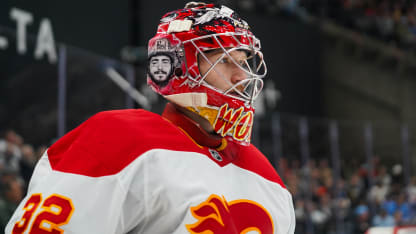Juuse Saros was too busy trying to keep the puck out of his Nashville Predators net to watch Dustin Wolf closely when he got his first NHL shutout at the other end on Nov. 15, but he has been paying attention to the impressive Calgary Flames rookie.
Saros told NHL.com he's been watching Wolf since he played for the United States as a 17-year-old at the 2018 Hlinka Gretzky Cup, and it's not just because the 6-foot Flames goalie is also considered "undersized" in an NHL where the average goalie was 6-foot, 2.98-inches last season, an all-time high.
"Obviously there's not many of us," said Saros, who at 5-foot-11 is the smallest goalie in the NHL this season. "But I don't really pay much attention to the size. I pay attention to how goalies play. There's a lot of saves you notice how he controls his body and how fast he changes direction, so all those little things as a goalie you really appreciate when you see that. His technical, his skating and all those little details are, I feel, better than anybody in the League, so that's what I feel all goalies can look up too."
That's high praise from Saros, who was a finalist for the Vezina Trophy as the NHL's best goalie in 2021-22 and has a career .917 save percentage in 369 games for the Predators, fifth among active players since entering the League in 2015-16.
In addition to the skating and skills, Saros has also taken note of where Wolf is playing, bucking some of the stereotypes that come with being a smaller goalie when it comes to positioning and depth in the crease. Despite the generalizations about needing to play more aggressively to make up for being smaller, Wolf has gone 8-3-1 with a .921 save percentage for the Flames this season while rarely venturing outside the blue ice of his crease.
"People that don't really know goaltending, I guess that's the easy thing to say, an easy headline," Saros said of the idea that smaller goalies need to play further out. "Especially because you don't have as long limbs, you've got to pick your spots when you can challenge, but when there's pass options and obviously the travel distance becomes bigger too when there's east-west plays, and you don't have that leverage of extending your limbs so far."
For Wolf, the contrarian depth adjustment started in his second full season with the Flames' American Hockey League affiliate. Wolf won the Aldege "Baz" Bastien Award as the AHL's most outstanding goalie in 2021-22, his first full professional season, but started playing deeper the next year after Calgary hired Mackenzie Skapski, a former goalie under New York Rangers goalie coaching legend Benoit Allaire, as their AHL goaltending coach.
Wolf's save percentage rose from .924 to .932 in that second season, he added a second straight Bastien Award and was also named AHL MVP.
"Coming from junior, guys are more skilled in the American League, so I played pretty far outside of my paint," Wolf said of that first season. "I still play outside my paint at times, but I play a lot deeper in a lot of scenarios, especially on the penalty kill or plays with an extra threat. You're not finding me two feet outside the blue and I think that's been super effective. I'm within my lines as [Skapski] likes to call it. I've simplified my game a lot. It makes moving within my paint so much easier. I'm relying on my tracking ability to pick up pucks from distance and not having to be three feet outside my net and it's been exponentially better."


















